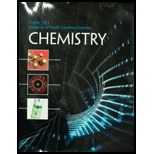
Calculate
Interpretation:
The equilibrium constant
Concept introduction:
The standard cell potential of a particular cell is given as:
Here,
The relation between the cell potential
The relation between standard Gibbs free energy
Answer to Problem 24QP
Solution:
(a)
(b)
(c)
Explanation of Solution
a)
This reaction can be written astwo half-reactions, as follows:
Fromtable
Now, the standard cell potential of the cell is given as:
Substitute the values of half-cell potential in the above expression.
The relation between standard Gibbs free energy
Here, the number of exchange of electrons is two;
Thus, the value of
Substitute the values of Faraday constant, the number of electrons transferred in the half-cell and the standard cell potential.
The relation between the cell potential
Substitute the values
Thus, the equilibrium constant of this reaction is
b)
This reaction can be written astwo half-reactions, as follows:
Fromtable
The standard cell potential of a cell is given as follows:
Substitute the values of half-cell potential in the above expression:
The relation between standard Gibbs free energy
Here, the number of exchange of electrons is four;
Thus, the value of
The Gibb’s energy is calculated by the expression as follows:
The relation between the cell potential
Substitute the values of
Thus, the equilibrium constant of this reaction is
c)
This reaction can be written astwo half-reactions as follows:
Fromtable
The standard cell potential of a cell is given as follows:
Substitute the values of half-cell potential in the above expression,
The relation between standard Gibbs free energy
Here, number of exchange of electrons is six;
Thus, the value of
Substitute the values of
The relation between the cell potential
Substitute the values of
Thus, the equilibrium constant of this reaction is
Want to see more full solutions like this?
Chapter 19 Solutions
CHEMISTRY >CUSTOM<
- Assign the functional group bands on the IR spectra.arrow_forwardFind the pH of a 0.120 M solution of HNO2. Find the pH ignoring activity effects (i.e., the normal way). Find the pH in a solution of 0.050 M NaCl, including activityarrow_forwardPlease help me answer these three questions. Required info should be in data table.arrow_forward
- Draw the major organic substitution product or products for (2R,3S)-2-bromo-3-methylpentane reacting with the given nucleophile. Clearly drawn the stereochemistry, including a wedged bond, a dashed bond and two in-plane bonds at each stereogenic center. Omit any byproducts. Bri CH3CH2O- (conc.) Draw the major organic product or products.arrow_forwardTartaric acid (C4H6O6) is a diprotic weak acid. A sample of 875 mg tartaric acid are dissolved in 100 mL water and titrated with 0.994 M NaOH. How many mL of NaOH are needed to reach the first equivalence point? How many mL of NaOH are needed to reach the second equivalence point?arrow_forwardIncluding activity, calculate the solubility of Pb(IO3)2 in a matrix of 0.020 M Mg(NO3)2.arrow_forward
- Order the following series of compounds from highest to lowest reactivity to electrophilic aromatic substitution, explaining your answer: 2-nitrophenol, p-Toluidine, N-(4-methylphenyl)acetamide, 4-methylbenzonitrile, 4-(trifluoromethyl)benzonitrile.arrow_forwardOrdene la siguiente serie de compuestos de mayor a menor reactividad a la sustitución aromática electrofílica, explicando su respuesta: ácido bencenosulfónico, fluorobenceno, etilbenceno, clorobenceno, terc-butilbenceno, acetofenona.arrow_forwardCan I please get all final concentrations please!arrow_forward
 Chemistry: Principles and ReactionsChemistryISBN:9781305079373Author:William L. Masterton, Cecile N. HurleyPublisher:Cengage Learning
Chemistry: Principles and ReactionsChemistryISBN:9781305079373Author:William L. Masterton, Cecile N. HurleyPublisher:Cengage Learning ChemistryChemistryISBN:9781305957404Author:Steven S. Zumdahl, Susan A. Zumdahl, Donald J. DeCostePublisher:Cengage Learning
ChemistryChemistryISBN:9781305957404Author:Steven S. Zumdahl, Susan A. Zumdahl, Donald J. DeCostePublisher:Cengage Learning Chemistry: An Atoms First ApproachChemistryISBN:9781305079243Author:Steven S. Zumdahl, Susan A. ZumdahlPublisher:Cengage Learning
Chemistry: An Atoms First ApproachChemistryISBN:9781305079243Author:Steven S. Zumdahl, Susan A. ZumdahlPublisher:Cengage Learning
 General Chemistry - Standalone book (MindTap Cour...ChemistryISBN:9781305580343Author:Steven D. Gammon, Ebbing, Darrell Ebbing, Steven D., Darrell; Gammon, Darrell Ebbing; Steven D. Gammon, Darrell D.; Gammon, Ebbing; Steven D. Gammon; DarrellPublisher:Cengage Learning
General Chemistry - Standalone book (MindTap Cour...ChemistryISBN:9781305580343Author:Steven D. Gammon, Ebbing, Darrell Ebbing, Steven D., Darrell; Gammon, Darrell Ebbing; Steven D. Gammon, Darrell D.; Gammon, Ebbing; Steven D. Gammon; DarrellPublisher:Cengage Learning Chemistry: Principles and PracticeChemistryISBN:9780534420123Author:Daniel L. Reger, Scott R. Goode, David W. Ball, Edward MercerPublisher:Cengage Learning
Chemistry: Principles and PracticeChemistryISBN:9780534420123Author:Daniel L. Reger, Scott R. Goode, David W. Ball, Edward MercerPublisher:Cengage Learning





